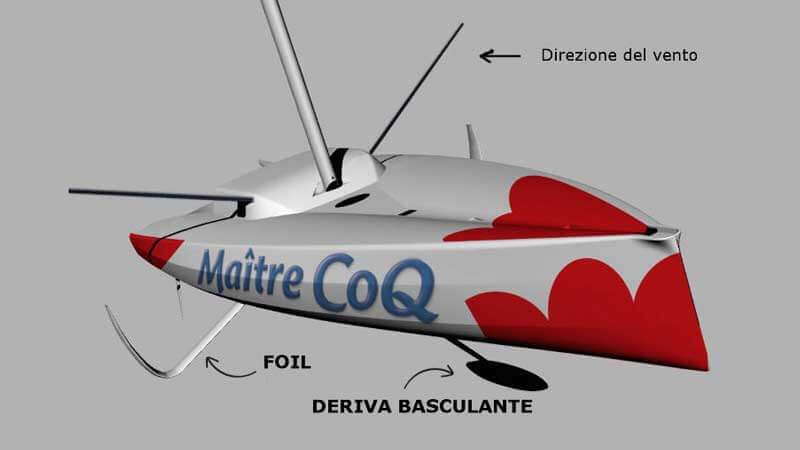[vc_row][vc_column][vc_column_text]Prendiamo una barca a vela di 50 piedi, circa 15 metri, per capirsi. Fino a vent’anni fa le più veloci di questa classe, realizzate in vetroresina, con percentuale di zavorra del 33% (quanta parte del peso totale dell’imbarcazione contribuisce al raddrizzamento della barca) nelle migliori condizioni meteomarine potevano toccare i 10-12 knots of speed.
Then came carbon fibre. Lighter boats than the 50% and with ballast percentages of the 60%. The speed reached 16-18 knotswith the possibility of long surfing on the waves with a lag gait.
NB: It is important to be able to straighten a boat because after a certain angle of swerve the water lines deform so much that it becomes unrideable (in technical jargon: heart-stopping) i.e. the boat continuously tends to go against the wind (in a rapid and uncontrolled manner) causing danger to the crew and still stopping. The less a boat heels (the maximum are about 20 degrees) and the faster it is.
Then came the tilting drift. Of course, it was racing technology, racing around the world. You needed hydraulic pistons, generators to put pressure on the system, etc. etc. But now the keel could heel upwind, so as to have more pull (torque) on the heel of the boat and allow more sail area to be carried, especially up at the masthead, where there is more wind. The top speed was up to 23-25 knots. And in round-the-world races this gave a great advantage: by adjusting well with the weather forecasts it was now possible to catch a disturbance near the Cape of Good Hope, hook it up and sail halfway around the world, down there at 60 degrees south latitude, where there is no land to bother the winds.
Then came the foils. Just when you thought you had seen it all and that a monohull boat couldn't go any faster, along came the flying machines. Of course, by the 1930s there was the Flying Motha three-and-a-half-metre dinghy raised on a rudder and T-drive; but those of the America's Cup class now they had invented flying monsters from 70 feet (21 metres) with two or three hulls rising on curved drifts. Computer-designed carbon blades lifting their hulls almost two metres above the water, drastically decreasing hydrodynamic resistance and increasing the speed disproportionately. But those were America's Cup catamarans, spaceships born for sheltered waters, on oceanic monohulls you couldn't do that, could you? Right?
Someone at that point must have remembered theengineer Gustav EiffelHe did not build the famous one to do a strange thing or to tickle the chauvinism of the French (there is no need in fact). The 324 metre high towercompleted in 1889, was used by the good Eiffel to conduct a series of experiments that laid the foundations for an entirely new science, aerodynamics. The experimental procedure was simple: Eiffel climbed to the top of the tower carrying different types of metal plates, then once he arrived he would look out from the balustrade and throw them down one by one. At street level, an assistant would take note of the flight time of each plate. In this way, Eiffel wanted to understand how shape affected the speed of fall.
Someone, then, at some point, remembering Eiffel's experiments must have thought: isn't it that many times we can limiting the heeling of monohull boats using these blessed foils? That is, if we put a load-bearing surface on the upper side of the foil placed downwind (the one that dives when the boat heels) perhaps this will generate enough force to right the boat a few degrees. And it worked. Quite a lot.
Today, the latest generation of monohulls about to leave for the2016 edition of the Vendee Globe, solo round-the-world racing without stopovers and assistance, all have canting keels and foils, and can sailing steadily around 30 knots. In the photos of the sea trials you can clearly see that species of shark fin which flanks the boat from downwind, sometimes brightly coloured.
So soon (end of November) we will be able to follow the exploits of this patrol of men, sailing across three oceansThey will attempt to circumnavigate the world in the shortest possible time. Riding some 25,000 miles, on carbon missiles that fly through the waves propelled only by the wind, at a speed worthy of an ultra-sporty speedboat. Of course, one must have steady nerves, a strong heart and a brain capable of putting itself on stand-by.
Sources: Wikipedia.org[/vc_column_text][/vc_column][/vc_row][vc_row][vc_column][mk_button dimension=”outline” corner_style=”full_rounded” size=”medium” icon=”mk-icon-home” url=”/” align=”center” margin_top=”30″ margin_bottom=”0″ margin_right=”0″]Torna alla Home[/mk_button][/vc_column][/vc_row]





